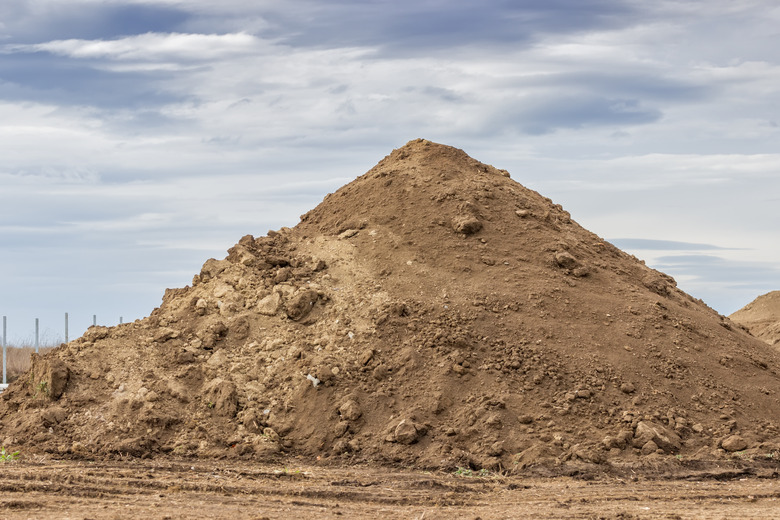How To Calculate Cubic Yards To Tons
Ever wonder if you'll need math skills in the real world? Imagine that your aunt is creating a garden and needs some topsoil hauled in. She tells you how many cubic yards she needs, and wants you to tell her how much all that dirt will weigh. Topsoil can be heavy, so your aunt doesn't want an answer in pounds – she wants an answer in tons. As long as you know how much volume your aunt is filling (that is, how many cubic yards of soil she'll use) and how much the topsoil weighs per cubic yard, you can find the answer for her quickly.
1. Find Volume in Cubic Yards
Measure or research the volume of space you'll be filling with soil. If you're already given the space's dimensions in cubic yards, you can continue to Step 2.
If you've measured or are given the individual dimensions of the space in linear yards – for example, you're told that your aunt is building one long garden bed that measures 1 yard by 3 yards by 1/5 yard deep – then you must multiply all three dimensions together to get the result in cubic yards:
\(1 \text{ yd} × 3 \text{ yd} × \frac{1}{5} \text{ yd} = \frac{3}{5} \text{ yd}^3\)
What if your measurements aren't given in yards, but in feet? Then you must convert to yards. If you're given linear measurements in feet, simply divide each measurement by 3 to get its equivalent in yards. So if you have a space that measures 3 feet × 9 feet × 6 feet, its equivalent in yards is:
\(1 \text{ yard} × 3 \text{ yards} × 2 \text{ yards}\)
If you're given the dimensions in cubic feet, you must divide by 27 to get the answer in cubic yards. So if you're told that the space you're dealing with measures 54 cubic feet, its equivalent in yards is:
\(\frac{54 \text{ ft}^3}{27} = 2 \text{ yd}^3\)
2. Find Weight Per Cubic Yard
If you're working a math problem in school, you'll be told how much your aunt's topsoil weighs per cubic yard. But in the real world you might have to do a little research, perhaps even calling the topsoil company to find how much their product weighs. For now, assume that it's a very wet spring and so the moisture-saturated topsoil is heavier than usual, weighing in at 1.2 tons per cubic yard.
You might be told the item's weight in pounds instead of tons. For example, you might be told that because the soil is damp, it weighs 2,400 pounds per cubic yard. Because you want your answer to be in terms of tons per cubic yard, you must convert that weight to tons before you can continue. To convert from pounds to tons, divide the number of pounds by 2,000. This gives you:
\(\frac{2400 \text{ pounds}}{2000} = 1.2 \text{ tons}\)
Warning
Before you go any further, make sure you're dealing with the correct type of ton. In United States units of measure, the ton (also known as the "short ton") is equivalent to 2,000 pounds, and in most school assignments, this is what you'll work with. But in British units of measure, the ton (also known as the "long ton") is equivalent to 2,240 pounds. And the metric ton used in most other countries is defined as 1,000 kg, which equals 2,204.6 pounds.
If you're dealing with real-world problems (or a sneaky teacher), there's a chance that the "tons" you've been given might actually be long tons or metric tons, and the differences between either measure and short tons can add up quickly – so always double-check.
3. Multiply Volume by Weight
Now that you know the weight and volume, multiply the two together. To recap, your aunt is building one long garden bed that measures 3/5 yd3, and the soil currently weighs 1.2 tons per cubic yard. So you have:
\(\frac{3}{5} \text{ yd}^3 × 1.2 \text{ tons/yd}^3 = 0.72 \text{ tons}\)
So based on the cubic yardage your aunt is filling, the topsoil will weigh 0.72 tons.
TL;DR (Too Long; Didn't Read)
Did you notice? You can cancel units of measure just like you cancel other terms in a fraction, which is why multiplying yd3 × tons/yd3 gives you a result in tons.
Cite This Article
MLA
Maloney, Lisa. "How To Calculate Cubic Yards To Tons" sciencing.com, https://www.sciencing.com/calculate-cubic-yards-tons-6471081/. 17 November 2020.
APA
Maloney, Lisa. (2020, November 17). How To Calculate Cubic Yards To Tons. sciencing.com. Retrieved from https://www.sciencing.com/calculate-cubic-yards-tons-6471081/
Chicago
Maloney, Lisa. How To Calculate Cubic Yards To Tons last modified August 30, 2022. https://www.sciencing.com/calculate-cubic-yards-tons-6471081/
